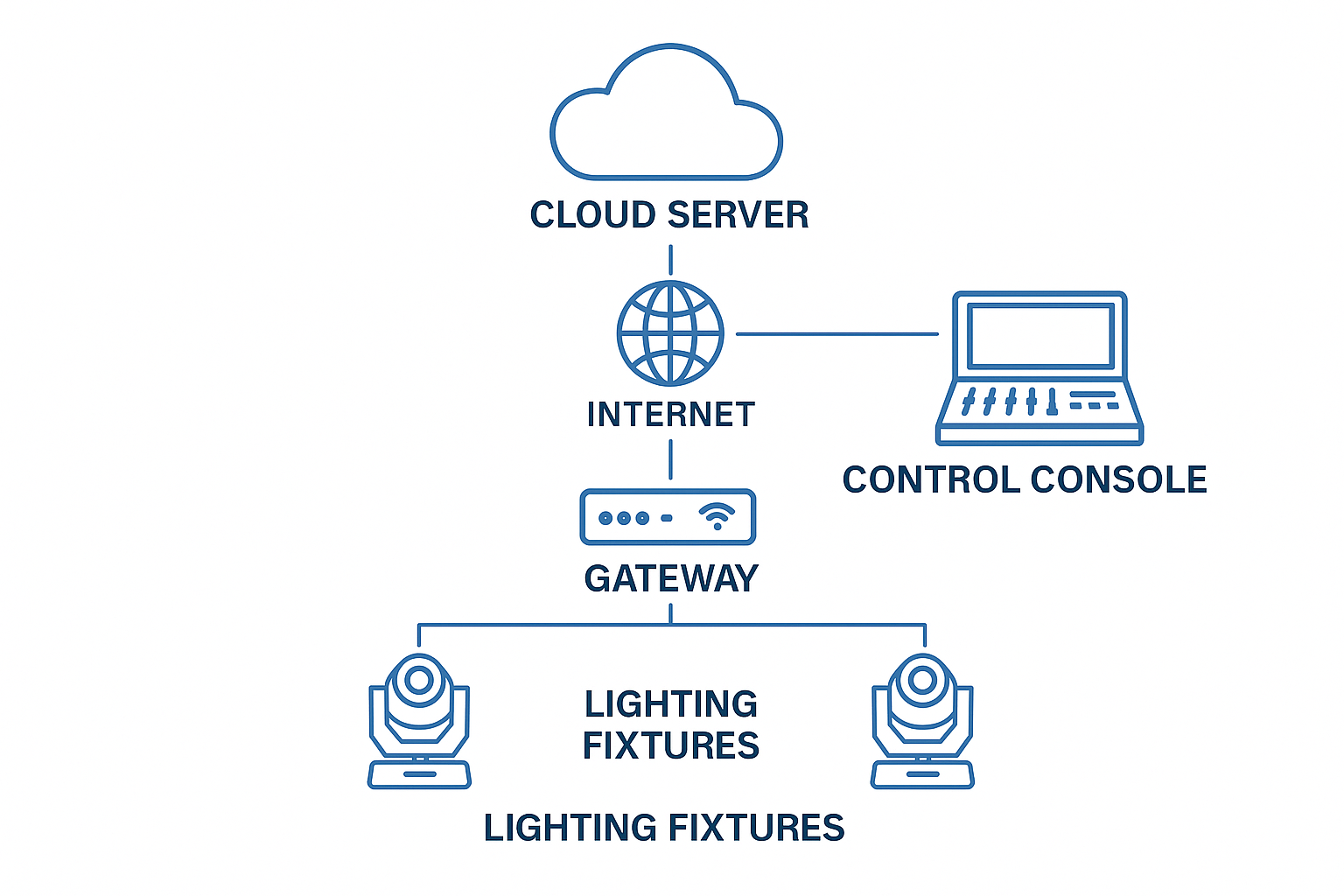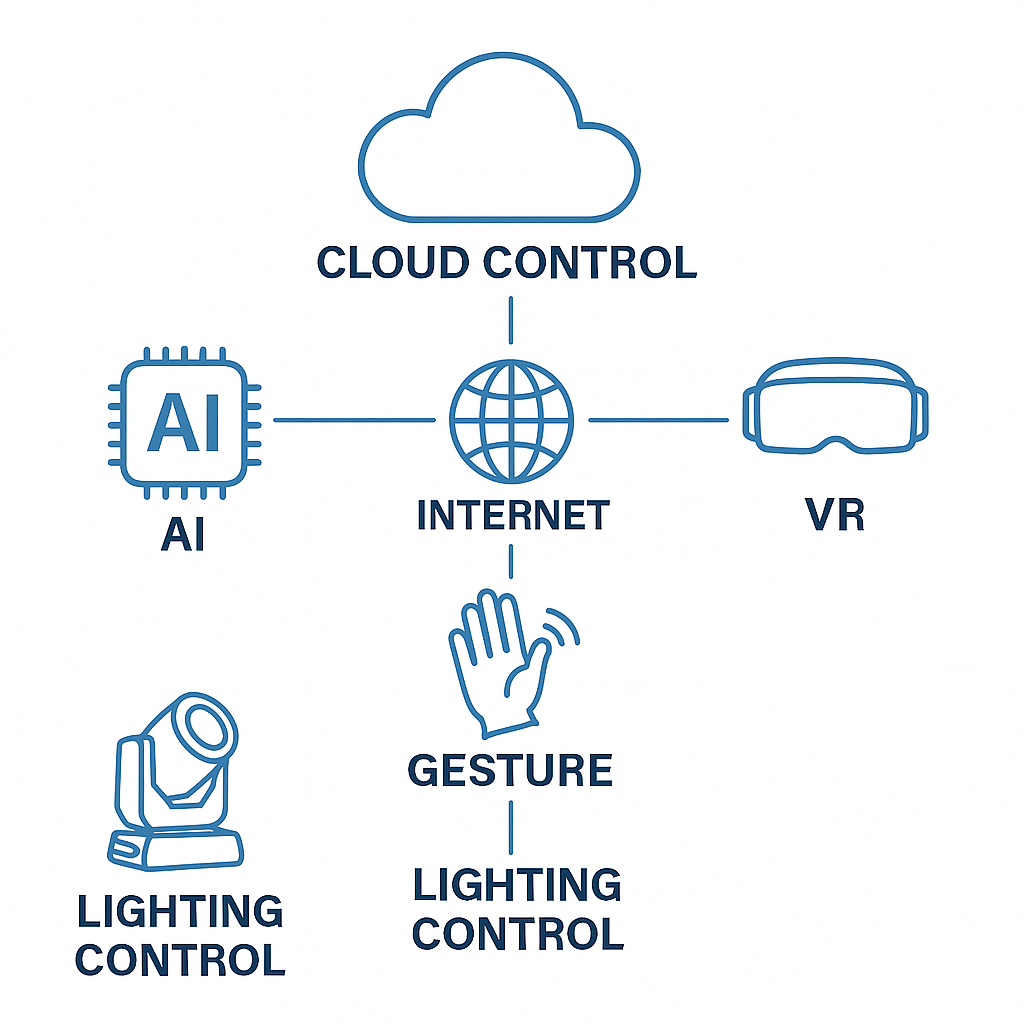In the evolving landscape of entertainment technology, the shift toward cloud-based lighting control has revolutionized how professionals design, program, and operate lighting systems. Whether used in theaters, concert tours, broadcast studios, or architectural installations, cloud integration offers unprecedented flexibility, collaboration, and scalability.
This article explores the fundamentals of cloud-based lighting systems, their advantages, the infrastructure required, and how this innovation is shaping the future of lighting control.
1. What Is Cloud-Based Lighting Control?
Cloud-based lighting control refers to managing lighting devices and control consoles over the internet using remote servers instead of local systems. Traditionally, lighting cues and configurations were stored on physical consoles or local networks. With cloud solutions, show files, presets, timelines, and even real-time control data are accessible and modifiable from any location via a secure online platform.
Key characteristics include:
Remote access to lighting consoles and files
Multi-device synchronization via a unified cloud environment
Collaborative programming for designers across regions
Storage and backup of lighting cues in the cloud
2. Advantages of Cloud-Integrated Lighting Systems
Cloud-based control brings several critical benefits that transform lighting operations:
A. Flexibility and Remote Management
Designers and technicians can log into their lighting systems from anywhere, whether for pre-programming a show, making emergency updates, or running cues remotely. This is especially useful in scenarios like:
Touring shows with offsite designers
Multi-location installs with centralized management
Streaming events with hybrid physical/virtual lighting designs
B. Real-Time Collaboration
Cloud systems allow multiple designers or programmers to collaborate on the same project file. Changes are synchronized in real-time, making co-programming and approval processes more efficient. Teams can divide programming tasks and test sequences concurrently.
C. Redundancy and Backup
Local lighting consoles are vulnerable to hardware failure. Cloud-based storage ensures redundancy, so projects can be restored quickly, avoiding delays or losses.
D. Scalability
From a single club to an international tour, cloud control systems can scale. There’s no need to overhaul infrastructure—devices can be added or removed, and settings applied across different sites with consistency.
3. System Requirements and Architecture
Cloud lighting control relies on a combination of hardware, software, and network infrastructure:
| Component | Description |
|---|---|
| Cloud Console Platform | Web-based or app-based interface for lighting control |
| Gateway Device | Converts local DMX/Art-Net/sACN signals into cloud-compatible streams |
| Internet Connection | High-speed and stable, preferably with failover support |
| Sync Protocol | Ensures real-time updates and command prioritization |
For maximum stability, many systems also include local fallback modes, ensuring continuity if the cloud connection is disrupted.

4. Security and Reliability Considerations
As with any cloud service, cybersecurity and data integrity are paramount. Reliable systems offer:
Encrypted communication between user interface and lighting network
Two-factor authentication for access control
Access logs to track user activity and system changes
Geo-redundant servers to prevent downtime
Professionals should work with IT teams to ensure secure ports, firewall configurations, and regular system updates. Integration with VPNs is often recommended.
5. Use Cases: When Cloud Control Makes Sense
| Use Case | Cloud Control Advantage |
|---|---|
| Touring Shows | Designers can prep shows remotely |
| Theme Parks | Centralized control across large installations |
| Corporate AV Systems | IT-integrated control via building infrastructure |
| Broadcast Studios | Cross-city programming and lighting file sharing |
| Architectural Lighting | Remote diagnostics and scheduling updates |
In many of these cases, cloud systems reduce travel costs, simplify logistics, and speed up programming timelines.
6. Challenges and Limitations
Despite its advantages, cloud-based lighting control presents a few limitations:
Internet Dependency: Disruption in service can affect programming or playback unless local backups are configured.
Learning Curve: Operators used to physical consoles may need training for new interfaces and workflows.
Latency: Though rare, some systems may experience slight latency based on internet quality and server proximity.
That said, most high-end systems offer hybrid models, blending cloud control with on-site redundancy to mitigate these risks.
7. The Future of Cloud-Controlled Lighting
As 5G, Wi-Fi 6, and fiber infrastructure become more widespread, cloud-based lighting will only grow in adoption. Future innovations may include:
AI-powered lighting assistants that learn from designers
Voice-activated or gesture-controlled cloud cues
Seamless cloud-DMX integration without physical converters
Moreover, showfiles and environments may live permanently in the cloud, accessible from consoles, tablets, or even VR-based design platforms.

READ MORE:





Blue Sea Lighting is an enterprise with rich experience in the integration of industry and trade in stage lighting and stage special effects related equipment. Its products include moving head lights, par lights, wall washer lights, logo gobo projector lights, power distributor, stage effects such as electronic fireworks machines, snow machines, smoke bubble machines, and related accessories such as light clamps.
Quick Links
For more questions subscribe to our email








